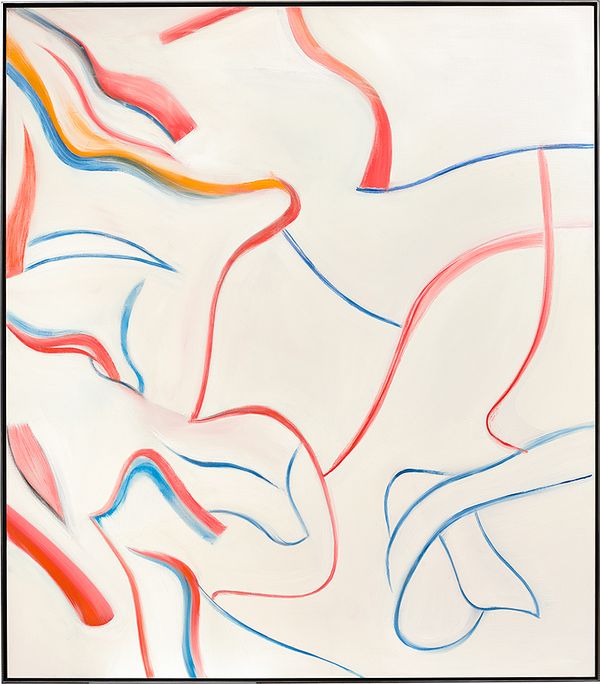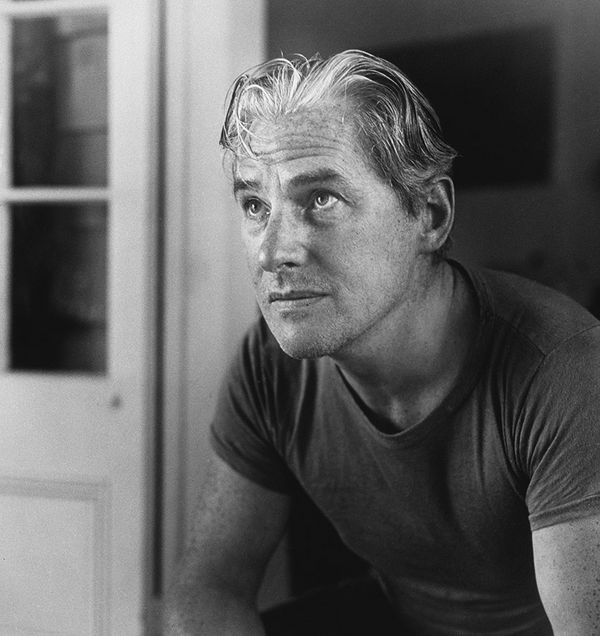The artist Willem de Kooning as a young man, August 1953, East Hampton. Photo by Tony Vaccaro/Getty Images.
Phillips invited elder statesman of the art world, Anthony Haden-Guest to take the long view of the life and career of Willem de Kooning — whose monumental triumph [no title] of 1984 features in our 20th Century & Contemproary Evening Sale in London on 2 March.
Willem de Kooning traveled from Holland to the United States as a stowaway, made it to New York in 1926, and soon, the 22 year old was putting bread on the table by painting houses, doing illustrations, and making displays for department stores as he worked on his art. In this he was doubly gifted, both at making incisive figurative drawings and painting abstractions, and such was his need to make art that he gave up that Depression rarity — a paying job — to work for the Works Progress Administration (WPA), the federal arts project, so as to be near working artists. There he was an assistant to Fernand Léger and, crucially, grew close to Arshile Gorky, through whom he learned how to absorb what he needed from Picasso’s Cubism, without being crushed by the maestro’s heft and reach.
De Kooning shortly became part of the emergence of Abstract Expressionism, the movement which would be swiftly accepted as having enabled New York to replace Paris as global capital of the contemporary art world. The AbEx group included Mark Rothko, Clifford Still, Barnett Newman, and Franz Kline, so it was hardly low on talent, but de Kooning and Jackson Pollock had soon emerged as contenders for leading roles. Then, as was humanly inevitable, came the sniping as to which deserved the number one spot; sniping in which both, from time to time, participated.
Their differences went deeper than manners of painthandling. When Hans Hofmann, the German AbEx artist, asked Pollock if he worked from nature, Pollock riposted “I am nature.” When de Kooning was explaining why he so liked the Hamptons in a letter to friends, he wrote: “For a painter like me it is much better to be surrounded by a small nature. Places like the Grand Canyon would frighten me to death.”
That was just a coincidence of phrasing, but it reflects the fact that the swirling planes on a Pollock canvas appear to have been executed with a deliberate indifference to the long-standing norms of composition, however these are the norms in which de Kooning was well schooled and used to his own remarkable ends. “De Kooning blew open the Cubist grid, changing its mode from structural to fluid,” in the words of the late New Yorker critic Peter Schjeldahl, a writer with un uncanny gift for getting into an artist’s head and brush hand, “De Kooning is to classical Cubism as flying is to walking.”
In 1950 de Kooning painted Excavations, a tremendous canvas, interpreted by his fellow AbExes, as a direct challenge to Pollock. This was one of the four de Koonings that Alfred Barr presented at the Venice Biennale in 1953. Three years later Pollock died, drunkenly crashing his car in Springs, New York. “It’s over. I’m number one,” de Kooning said at the funeral.
De Kooning settled down to decades of making abstractions infused with a sense of the real, works which could seem crowded, but each of which was singularly resolved. He matched Picasso and Matisse for longevity, but his progress was very different from either. Matisse’s final work, his paper cut-outs, were well received. Picasso’s last canvases were expressively Picassoid, indeed controversially so, and it took a while before they got critical recognition and market acceptance.
The changes in the paintings of de Kooning’s last period were more striking than either. These spare, pure canvases are at once serene and high energy, alive with looping, form-defining lines, and always achieving a deeply satisfying resolution; they take abstraction to places where it has never been. In his old age, de Kooning retained a magic wrist such as few others, and had decades of craft moves embedded in his head.
“Pollock may be our greatest artist,” wrote Carter Ratcliff in The Fate of a Gesture. “Some have nominated Jasper Johns or Andy Warhol for that position. Undoubtedly, though, our greatest painter is de Kooning.” Peter Schjeldahl wrote, “The art of painting does not get more exciting than Willem de Kooning on a good day.” This painting was made on one of his best.

Willem de Kooning, [no title], 1984. 20th Century and Contemporary Art Evening Sale, London.
Estimate: £7,000,000–9,000,000. View lot >
Anthony Haden-Guest is a writer, cartoonist, art critic, and frequent contributor to publications across the art and culture spheres. An elder statesman of the art scene, his books include TRUE COLORS: The Real Life of the Art World and The Last Party: Studio 54, Disco and the Culture of the Night, along with collections of verse, cartoonery, and critique. He lives and works in New York and London.
Auction /
20th Century & Contemporary Art Evening Sale
2 March, 5pm
30 Berkeley Square, London (map)
Viewing /
23 February – 2 March
Monday-Saturday 10am – 6pm
Sunday 12pm – 6pm
Discover More from 20th Century & Contemporary Art >
Recommended Reading
New Talent Speaks: Five emerging artists to benefit Foster Pride >
Wave After Wave: Paul Laster on six women artists on the contemporary crest >
